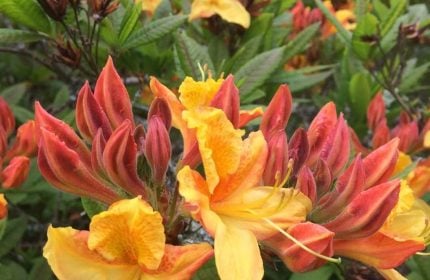What to prune and when? Here’s how to cut back shrubs at the right time
It’s almost time for plants to start back into life, when gardeners dust off their secateurs to get their prized shrubs and trees into shape.
New buds are usually clearly visible by the end of February, and it’s best to finish winter pruning before the spring growth really gets underway.
But it can be confusing for newcomer gardeners to know which plants to prune when, especially as if you start snipping at the wrong time, you could end up losing a load of this season’s flowers.
View this post on Instagram
Rose pruning before spring! #ouch #climbingroses #winterpruning #leastfavouritejob
So, here’s a quick guide to take you through the key points…
What to prune now
The general rule of thumb is that if your shrubs are deciduous and flower from late summer to autumn, then you can prune them in spring.
Before new spring growth starts, you can tidy up some woody plants, pruning broken stems which are rubbing up against each other, taking them back to a healthy bud or a main stem, and generally getting shrubs back into shape while they are leafless.
Plants including Buddleia davidii, potentilla, fuchsia, dogwood and wisteria can be tidied up now. Buddleia davidii is a vigorous shrub, which will come back stronger, so you can cut the stems down to 20cm high.
Cut back old wood hard – old wood looks rougher and darker – to a low bud to encourage strong new growth which will bear flowers in the same year.
Cut back wisteria
This glorious climbing shrub, whose purple flowers adorn the walls of houses during the summer months, needs pruning twice a year – once at the end of summer and again in late winter.
Cut back last season’s long sideshoots to two or three buds. This process produces spurs, which allow the fatter buds to remain and bear larger flowers. It’s also a good time to tidy the plant up generally, removing wispy growths, says the RHS.
Deal with dogwood

Cut dogwood stems to the ground
Dogwood, which is grown for its colourful winter stems, can be cut down to the ground. This will re-energise the plant and encourage many new colourful stems for next winter.
Watch the weather
In milder areas, start to tidy up bush roses, removing thin shoots and dead, diseased and dying stems. But if the weather is really cold, wait until next month.
Timing can depend on where you live. If you’re in a really cold area, leave hard pruning until March, as pruning stimulates growth and any resulting young leaves may be damaged by frost.
Cut certain clematis

Group 3 clematis can be pruned
You can also prune large-flowering clematis (group 3) such as Clematis viticella and hybrids such as C. ‘Jackmanii’ and ‘Etoile Violette’, which flower in late summer, cutting the stems back down to 30cm (12in) to promote good growth.
Prune to a ‘nodal point’, just above a pair of leaves or buds, where the cut is more likely to heal. If you cut where there aren’t buds, you could end up with fungal infections and die-back.
You can also tackle winter-flowering jasmine, untangling the strands and cutting out dead, diseased and damaged stems. To give it a sound framework for next year, tie in new stems to the support system and trim back the sideshoots to within about 5cm (2in) of the main stem.
What not to prune now

Wait until forsythia has flowered in spring before you prune it
Avoid pruning shrubs whose flowers are produced on shoots which developed in the previous growing season. The flowering shoots should be cut as soon as they have finished flowering, to allow new shoots to form.
These include spring and early summer-flowering shrubs such as forsythia, which blooms in March and April, weigela, kerria and philadelphus (mock orange).
Help overgrown shrubs feel better
While it’s still cold enough, you can renewal-prune overgrown shrubs but don’t go mad. Just take it in stages, removing some of the oldest branches each winter so that the plant will slowly rejuvenate, replacing those old branches with new ones over time. Within a few years, your shrub should have been revitalised with strong, healthy young growth.
The Press Association
Latest posts by The Press Association (see all)
- World Penguin Day: Test your knowledge with our penguin-themed quiz - April 23, 2024
- Kate’s new photo of Louis released to celebrate prince’s sixth birthday - April 23, 2024
- Alan Titchmarsh: Slugs are never going to be my friends - April 23, 2024
- Prince Louis celebrates sixth birthday - April 23, 2024
- Special episode of Planet Earth III to be narrated by schoolchildren - April 22, 2024






















